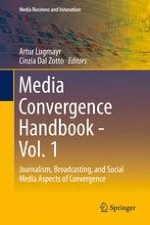2016 | OriginalPaper | Buchkapitel
Influence of Convergent Media on the Perception of Information Credibility
verfasst von : Daria Mustić, Mario Plenković
Erschienen in: Media Convergence Handbook - Vol. 1
Verlag: Springer Berlin Heidelberg
Aktivieren Sie unsere intelligente Suche, um passende Fachinhalte oder Patente zu finden.
Wählen Sie Textabschnitte aus um mit Künstlicher Intelligenz passenden Patente zu finden. powered by
Markieren Sie Textabschnitte, um KI-gestützt weitere passende Inhalte zu finden. powered by
